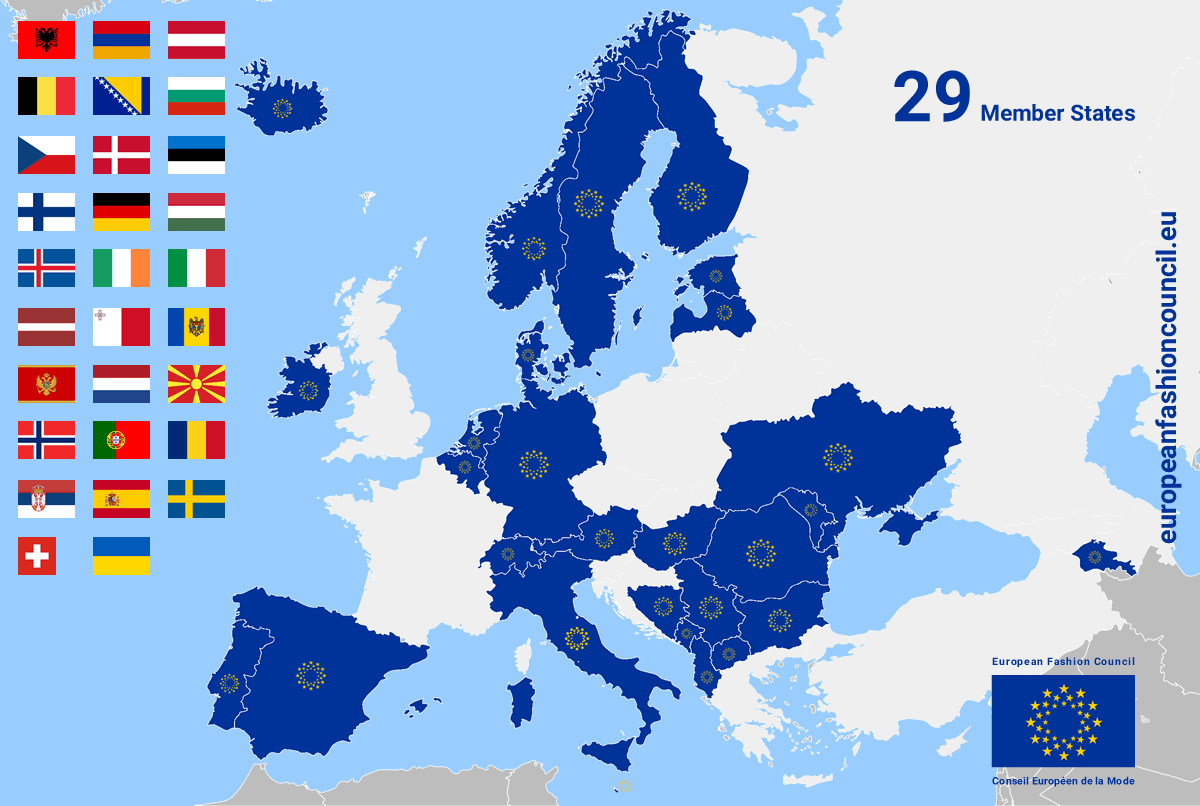Founders and Members of the European Fashion Council by Year of Accession
This timeline illustrates the gradual expansion of the European Fashion Council, starting with 11 founding member states in 2007 and growing to a total of 29 members by 2024. Each country’s inclusion represents a step toward fostering cultural and economic collaboration in fashion across Europe.
2007 – Founding Members:
- Albania
- Austria
- Belgium
- Bosnia and Herzegovina
- Bulgaria
- Denmark
- Estonia
- Hungary
- Norway
- Romania
- Ukraine
2008
- Iceland
- Netherlands
2012
- Serbia
2010
- Armenia
- Czechia
- Latvia
- Malta
2011
- Sweden
2014
- Montenegro
- North Macedonia
- Portugal
2015
- Germany
- Switzerland
2016
- Ireland
2017
- Finland
- Moldova
2019
- Spain
2024
- Italy
In alphabetical order
- Albania
- Armenia
- Austria
- Belgium
- Bosnia and Herzegovina
- Bulgaria
- Czechia
- Denmark
- Estonia
- Finland
- Germany
- Hungary
- Iceland
- Ireland
- Italy
- Latvia
- Malta
- Moldova
- Montenegro
- Netherlands
- North Macedonia
- Norway
- Portugal
- Romania
- Serbia
- Spain
- Sweden
- Switzerland
- Ukraine
The European Fashion Council (EFC) is a unique organization that extends its representation beyond the member states of the European Union (EU). Unlike many organizations that are EU-centric, the EFC encompasses members from all countries that are part of the Council of Europe. This broad representation fosters a more inclusive approach to cultural, artistic, and economic collaboration across the continent.
Understanding the Council of Europe and the European Union
The Council of Europe and the European Union are two distinct entities, each with specific roles and objectives:
Council of Europe (CoE):
- Established in 1949, the CoE is focused on promoting human rights, democracy, and the rule of law across Europe.
- It has 46 member states, including countries outside the EU, such as Norway, Switzerland, Turkey, and Ukraine.
- The CoE is best known for creating the European Convention on Human Rights and establishing the European Court of Human Rights.
> coe.int
European Union (EU):
- Founded in 1993, the EU is a political and economic union with 27 member states.
- It aims to promote economic integration, free movement of goods and people, and standardized legislation across its members.
- Key EU institutions include the European Parliament, the European Commission, and the Council of the European Union (different from the Council of Europe).
> european-union.europa.eu
EFC’s Unique Position
By representing countries from the Council of Europe rather than limiting itself to EU member states, the EFC creates opportunities for collaboration and cultural exchange across a broader geographic and cultural spectrum. This inclusivity allows the EFC to bring together designers, artists, and institutions from diverse political, cultural, and economic backgrounds, strengthening Europe’s position as a global leader in fashion and design.
For example:
- The EFC’s inclusion of non-EU countries like Armenia, Serbia and Ukraine enriches its network with unique cultural influences.
- This broader scope aligns with the CoE’s mission to promote cultural diversity and human rights, while complementing the EU’s economic and social policies.
By bridging the two frameworks, the EFC embodies a vision of unity that transcends political boundaries, reflecting the shared heritage and aspirations of all European nations.

